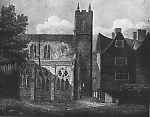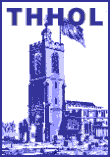In 1913 the London County Council ordered that Little Thames Street, a portion of Little Tower Hill and Lower East Smithfield, all within the Borough of Stepney, should be renamed and hence forth known as St. Katharine's Way. The name is attractive, but it may be said at once that the walk is not pleasing to the eye. It will afford, however, an experience for those who are curiously minded, and some matter for reflection to the meditative. If the walk is continued, as it should be if it is once begun, by Burr Street and Nightingale Lane into Upper East Smithfield, the circuit of St. Katharine Dock will have been completed with a strange feeling of satisfaction or relief according to temperament. On a Saturday or Sunday afternoon here a silence broods in solitude, and there is borne in the air that indescribable yet familiar odour that hangs about warehouses and docks, blended with the aroma of cinnamon, the scent of tea, the pungency of oranges, the smell of malt and the fragrancy of perfumed soap. Little else will have been seen but high walls and lofty warehouses: it is the region of bricks and mortar. The person who traverses it throughout will be, in common parlance, a "brick" to have done so.
Nightingale Lane has no rateable premises in it. Nearly all its extent it separates St. Katharine's Docks from the London Docks, and runs between high walls which recede as they rise. The name of the lane is very old, and some say that it was not given in honour of Philomel, the sweet songster, but because it was the boundary of the lands once held by the Knighten Guild.
Well-nigh a thousand years ago, in the days of King Edgar, who reigned from 959 to 975, there were (to quote the account given by Stow) "thirteen knights or soldiers, well-beloved to the king and realm, for service by them done, which requested to have a certain portion of land on the east part of the city, left desolate and forsaken by the inhabitants by reason of too much servitude. They besought the king to have the land, with the liberty of a guild for ever. The king granted to their request, with the conditions following: that is, that each of them should victoriously accomplish three - combats, one above the ground, one under ground, and the third in the water; and after this, at a certain day in East Smithfield they should run with spears against all comers; all which was gloriously performed; and the same day the king named it Knighten Guild. . ."
The lands outside the city walls that were granted by the king extended to Bishopsgate Without on the north, and to where Middlesex Street now stands on the east. On the south "unto the river of Thames, and so far into the water as a horseman entering the same may ride at low water, and throw his spear." The open ground southwards of Aldgate that stretched down to the Thames was called East Smithfield. The members of the Knighten Guild in 1115 granted their estate to the Priory and Convent of Holy Trinity, Aldgate, which grant King Henry I confirmed.
 The
Hospital of St. Katharine is associated with the names of three illustrious women, Queens Consort
of England, and worthily so, because the Saint herself was of Royal blood. First, Matilda (Maud)
wife of Stephen, founded it about 1148 as an act of remembrance of her two children who died
and were buried in Holy Trinity Priory. She was extremely and deservedly popular during the
troublous time in which she lived. Afterwards the Hospital was refounded by Eleanor the widow
of Henry III. Philippa, the famous wife of Edward III, founded a chantry there.
The
Hospital of St. Katharine is associated with the names of three illustrious women, Queens Consort
of England, and worthily so, because the Saint herself was of Royal blood. First, Matilda (Maud)
wife of Stephen, founded it about 1148 as an act of remembrance of her two children who died
and were buried in Holy Trinity Priory. She was extremely and deservedly popular during the
troublous time in which she lived. Afterwards the Hospital was refounded by Eleanor the widow
of Henry III. Philippa, the famous wife of Edward III, founded a chantry there.
The site of the Hospital was given by Holy Trinity Priory, it being part of the ancient East Smithfield. When the neighbourhood of the edifice became an important place owing to its proximity to the river and the City, the relative descriptions were reversed, and the remaining portion of East Smithfield was deemed to be within the Precinct of St. Katharine.
The transfer of the possessions of the Knighten Guild to Holy Trinity Priory immediately brought about trouble with Geoffrey de Magnaville, Constable of the Tower. Having taken a piece of ground in East Smithfield and made it into a vineyard, he and his successors held it by force. The situation of the vineyard cannot be identified, but it doubtless became attached to Tower Hill which it adjoined.
In 1229 a grant was made by Henry III to hold a fair for fifteen days following the eve of Pentecost, and orders were sent to the Sheriffs throughout England to proclaim the fair and to cause all merchants within their jurisdiction to know that they might securely come to it. A few years later, in 1236, the same king was concerned with the safety of the Jews, and under the protection of the Constable of the Tower a Jewry was formed. The actual site is not known, but it has been suggested that it was on the north-east side of the Hospital. Among the perquisites enjoyed by the Constable of the Tower in the reign of Richard II was that of receiving money from persons who dried skins in East Smithfield. The custom may have been a survival of the price of protection by the Jews before they were expelled.
In 1348 there was a great pestilence, and for want of room in the churchyards of the City to bury the dead, a piece of ground was enclosed in East Smithfield for this purpose. Edward III who, when in the peril of shipwreck some years previously had vowed to build a monastery, superstitiously thought the pestilence was a reminder, and erected a religious house which was known as the Abbey of Our Grace, and it is sometimes referred to as Eastminster. It was not a magnificent pile as it is sometimes supposed. At the dissolution of the monasteries it was demolished, and a large building erected where biscuits were baked for the Navy. So it became the Victualling Office, and was afterwards used as the Tobacco warehouses. The Royal Mint now stands on part of the site.
By a charter of Henry IV, in 1442, the neighbourhood of the Hospital was constituted a Precinct free from jurisdiction civil or ecclesiastical, except that of the Lord Chancellor. This state lasted until the Reformation. To help the funds there was a further grant of the right of a fair within the Precinct to last twenty-one days from the feast of St. James (25th July). This right was craftily sold in the sixteenth century to the City of London.
Into East Smithfield in the reign of Elizabeth came a journeying tailor, John Spenser, who had come to London from Pendleton, Lancashire, and here three children were born - two boys and a girl. He was evidently in needy circumstances, for his boys went as "pore scholars" to the newly-founded school of the Merchant Taylors. Edmund Spenser, the poet who wrote The Faerie Queen, was one of the boys, and by acting in a school play probably owed his first appearance at Court before his Gloriana, Queen Elizabeth. He has been called the Prince of Poets and the "poets' Poet," and if The Faerie Queen is not read much nowadays, it is, and will remain ever, a masterpiece of English literature.
Down by the riverside, St. Katharine's Quay became frequented by Dutch ships, and foreigners who were not allowed to trade within the City congregated there. When Calais was given over to the French, the inhabitants evacuated the place, and those of the two districts of Hammes and Guisnes settled in the Precinct of St. Katharine, and the name of the locality became corrupted into Hangman's Gains.
A return of foreigners made in 1572 showed that there were in the Precinct then 425, many of whom were shoemakers. The numbers of the different nationalities were as follows: 828 Dutch, 69 French (mostly hat makers), 8 Danes, 5 Polanders, 2 Spaniards, 1 Italian, 12 Scots. Some thirty of the Dutch were engaged in brewing. St. Katharine's thrived, and from its situation and appearance it was at this time not at all an unpleasant place, with its rectangular blocks of quaint wooden dwellings and inns surrounding the Hospital. Among its amenities were stocks, pillory, whipping-post, and a maypole. Unfortunately, as the shipping and commerce increased, the seeds of its degradation were sown, and afterwards for two hundred years and more it was a blot on the outskirts of the City.
All vestige of the Precinct was removed in the construction of St. Katharine's Docks. The ground was cleared of the pre-Reformation Chapel and of 1,250 houses of the meanest description which had sheltered 11,300 inhabitants, who spread into adjacent districts. The first stone was laid 3 May 1827, and with so much speed and vigour was the work done that the docks and ware houses covering twenty-four acres were opened on 25 October 1829. The Docks Company paid £125,000 for the Precinct, and was required to spend £30,000 for the new Hospital erected in Regent's Park, and to pay £2,000 for the new site.
by Sydney Maddocks
